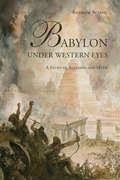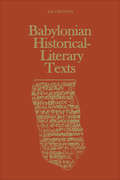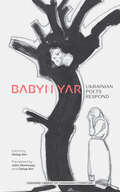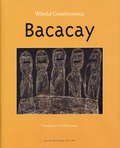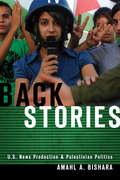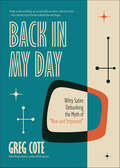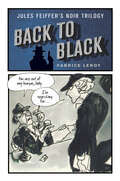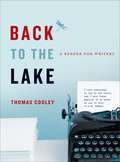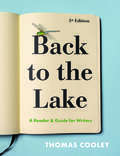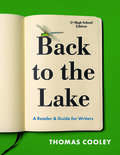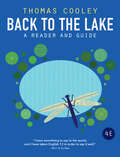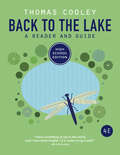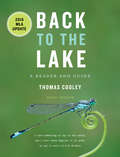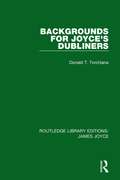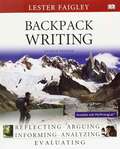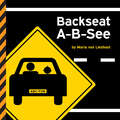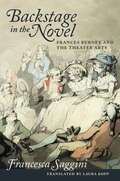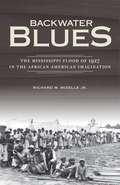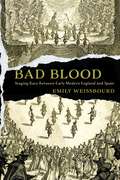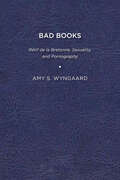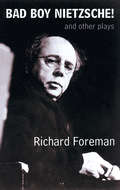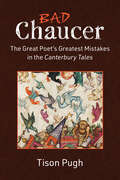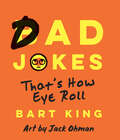- Table View
- List View
Babylon Under Western Eyes: A Study of Allusion and Myth
by Andrew ScheilBabylon under Western Eyes examines the mythic legacy of ancient Babylon, the Near Eastern city which has served western culture as a metaphor for power, luxury, and exotic magnificence for more than two thousand years.Sifting through the many references to Babylon in biblical, classical, medieval, and modern texts, Andrew Scheil uses Babylon's remarkable literary ubiquity as the foundation for a thorough analysis of the dynamics of adaptation and allusion in western literature. Touching on everything from Old English poetry to the contemporary apocalyptic fiction of the "Left Behind" series, Scheil outlines how medieval Christian society and its cultural successors have adopted Babylon as a political metaphor, a degenerate archetype, and a place associated with the sublime. Combining remarkable erudition with a clear and accessible style, Babylon under Western Eyes is the first comprehensive examination of Babylon's significance within the pantheon of western literature and a testimonial to the continuing influence of biblical, classical, and medieval paradigms in modern culture.
Babylonian Historical-Literary Texts
by Albert Kirk GraysonEarly Assyriologists were lured to Babylonian studies by the light which cuneiform text shed on ancient history and the Bible, and for later scholars this is still the attraction. The Age of Discovery is not past, and one can still read literature that has been unseen by the eyes of man for millennia. There are myriads of tablets lying in the ancient ruins of Iraq, Iran, Syria, and Turkey, waiting for the excavator's spade; in museums there are quantities of inscriptions that have not yet been made public.
Babyn Yar: Ukrainian Poets Respond (Harvard Library of Ukrainian Literature #4)
by Ostap KinIn 2021, the world commemorates the 80th anniversary of the massacres of Jews at Babyn Yar. The present collection brings together for the first time the responses to the tragic events of September 1941 by Ukrainian Jewish and non-Jewish poets of the Soviet and post-Soviet periods, presented here in the original and in English translation by Ostap Kin and John Hennessy. Written between 1941 and 2018 by over twenty poets, these poems belong to different literary canons, traditions, and time frames, while their authors come from several generations. Together, the poems in Babyn Yar: Ukrainian Poets Respond create a language capable of portraying the suffering and destruction of the Ukrainian Jewish population during the Holocaust as well as other peoples murdered at the site.
Bacacay
by Witold Gombrowicz Bill JohnstonA balloonist finds himself set upon by erotic lepers...a passenger on a ship notices a human eye on the deck...a group of aristocrats enjoy a vegetarian dish made from human flesh...a virginal young girl gnaws raw meat from a bone...a notorious ruffian is terrorized by a rat. Welcome to the bizarre universe of Witold Gombrowicz, whose legendary short story collection is presented here for the first time in English. These tales, hilarious, disturbing, and brilliantly written, are utterly unique in world literature. After reading them, you'll never be the same.
Back Stories: U.S. News Production and Palestinian Politics
by Amahl A. BisharaFew topics in the news are more hotly contested than the Israeli-Palestinian conflict—and news coverage itself is always a subject of debate. But rarely do these debates incorporate an on-the-ground perspective of what and who newsmaking entails. Studying how journalists work in Jerusalem, Bethlehem, Ramallah, and Nablus, and on the tense roads that connect these cities, Amahl Bishara demonstrates how the production of U.S. news about Palestinians depends on multifaceted collaborations, typically invisible to Western readers. She focuses on the work that Palestinian journalists do behind the scenes and below the bylines—as fixers, photojournalists, camerapeople, reporters, and producers—to provide the news that Americans read, see, and hear every day. Ultimately, this book demonstrates how Palestinians play integral roles in producing U.S. news and how U.S. journalism in turn shapes Palestinian politics. U.S. objectivity is in Palestinian journalists' hands, and Palestinian self-determination cannot be fully understood without attention to the journalist standing off to the side, quietly taking notes. Back Stories examines news stories big and small—Yassir Arafat's funeral, female suicide bombers, protests against the separation barrier, an all-but-unnoticed killing of a mentally disabled man—to investigate urgent questions about objectivity, violence, the state, and the production of knowledge in today's news. This book reaches beyond the headlines into the lives of Palestinians during the second intifada to give readers a new vantage point on both Palestinians and journalism. Show more
Back in My Day: Witty Satire Debuking the Myth of "New and Improved"
by Greg CoteIn this witty satire book, Greg Cote questions whether advances in technology always signify progress or if they are sometimes overrated.#1 New Release in History HumorA humorous look at the past. Step into world of Back in My Day with Greg Cote, acclaimed Miami Herald columnist and podcaster. Through a collection of short essays, Cote delivers lighthearted yet thought-provoking rants on the perceived "new and improved" aspects of modern life through interesting stories. More than just a satire book. It's a journey through fun trivia, random interesting facts, and captivating stories. Perfect for fans of the Dan LeBatard Show and those seeking a dose of wit and wisdom, this book promises an entertaining read that leaves a lasting impression. Inside you'll find: Greg Cote's delightful exploration of the quirks and nuances of modern living. A chance to laugh, ponder the insights, and revel in the joy of discovering the unexpected. Stories of nostalgia to entertain an enlighten. If you liked I Remember That , Why Do We Say That?, or The Origin of Names, Words and Everything in Between, you'll love Back in My Day
Back to Black: Jules Feiffer’s Noir Trilogy (Critical Graphics)
by Fabrice LeroyThe legendary American cartoonist and author Jules Feiffer has enjoyed a long and varied career, working on everything from illustrating The Phantom Tollbooth to writing the screenplay for the film Popeye. But some of his most innovative work came very late in his career, with a trio of graphic novels he composed in his eighties: Kill My Mother (2014), Cousin Joseph (2016), and The Ghost Script (2018). Back to Black provides the first full-length critical analysis of this trilogy, exploring how it pays homage to the iconography and themes of film noir through constant graphic experimentation and a striking reinvention of Feiffer’s distinctive style. Fabrice Leroy shows how Feiffer deftly alternates between dramatic and satirical tones as he plays with the conventions of noir to provide a caustic yet moving commentary on mid-twentieth-century American life. Through close readings of each novel in the trilogy, he examines Feiffer’s singular depiction of the central political issues in the United States from the Great Depression to the 1950s, which still resonate today: unionization struggles, cinematic propaganda, McCarthyism, the American Dream, immigration, antisemitism, civil rights, and gender discrimination. Placing the noir trilogy into the context of Feiffer’s long career, Back to Black demonstrates how he offers a loving pastiche of the genre without losing his unique voice or critical edge.
Back to the Lake
by Thomas CooleyTaking its title from Once More to the Lake, the classic essay by E. B. White found in all rhetorically arranged readers, Back to the Lake offers much that is new, from 40 readings never before anthologized in a composition reader to templates to help students get started.
Back to the Lake (Fifth Edition): A Reader And Guide For Writers
by Thomas CooleyA balance of excellent model readings and writing advice that builds students’ skills with rhetorical patterns A “thorough and engaging writing guide for students who need direction and encouragement” (Matt Byars, instructor at Lubbock Christian University), Back to the Lake shows students the connections between smart writing strategies and effective model essays. Robust and practical writing advice—with innovative templates to get started writing—is supported by interesting readings arranged by rhetorical mode and written by a mix of classic, contemporary, and student writers. Now with a new chapter on “Elements of the Essay”; a new modes chapter on “Analysis” covering critical and process analysis; and almost 50 percent new readings. Now available in a more interactive ebook version that takes student reading to the next level with questions that help them check their comprehension as they read. This purchase offers access to the digital ebook only.
Back to the Lake (Fifth High School Edition): A Reader And Guide For Writers
by Thomas CooleyA balance of excellent model readings and writing advice that builds students’ AP® skills. Back to the Lake shows the connections between smart writing strategies and effective model essays. Robust and practical writing advice—with innovative templates to get started writing—is supported by interesting readings arranged by rhetorical mode and written by a mix of classic, contemporary, and student writers. Alongside the new AP® Course Planning and Pacing Guide and AP® Correlation Guide, Back to the Lake's student-friendly writing guidance and exemplar works build students' AP® Skills and prepare them for AP® exams. New content includes a new chapter on “Elements of the Essay”; a new chapter on “Analysis” covering critical and process analysis; and almost 50 percent new readings. A new, more interactive ebook version takes student reading to the next level with Check Your Understanding questions to reinforce comprehension as they read. AP® is a trademark registered and/or owned by the College Board, which was not involved in the production of, and does not endorse, this product. This purchase offers access to the digital ebook only.
Back to the Lake (Fourth Edition): A Reader And Guide
by Thomas CooleyThe perfect balance of readings and writing instruction The reader and writing guide that helps developing writers succeed using engaging essays and practical writing instruction. Back to the Lake presents reading and writing strategies together using marginal annotations to show the connections. Readings—arranged by strategy and written by classic, contemporary, and student writers—are balanced with writing advice. Now with new readings—including ones debating the value of “grit”—new advice on reading critically, and a new chapter on editing sentences. This purchase offers access to the digital ebook only.
Back to the Lake (Fourth High School Edition)
by Thomas CooleyThe perfect balance of readings and writing instruction for the AP® Language and Composition course This reader and writing guide supports AP® Language and Composition students using engaging essays and practical writing instruction. Back to the Lake helps students understand rhetorical situations, develop claims, guide arguments with clear organization, and make strategic stylistic choices. The book presents reading and writing strategies together using marginal annotations to show the connections. Readings—arranged by method of development and written by classic, contemporary, and student writers–are balanced with writing advice. AP® is a trademark registered and/or owned by the College Board, which was not involved in the production of, and does not endorse, this product. This purchase offers access to the digital ebook only.
Back to the Lake, A Reader and Guide, Third Edition
by Thomas CooleyBack to the Lake by Thomas Cooley
Backgrounds for Joyce's Dubliners (Routledge Library Editions: James Joyce #8)
by Donald T. TorchianaFirst published in 1986. Dubliners was James Joyce’s first major publication. Setting it at the turn of the century, Joyce claims to hold up a ‘nicely polished looking-glass’ to the native Irishman. In Backgrounds for Joyce’s Dubliners, the author examines the national, mythic, religious and legendary details, which Joyce builds up to capture a many-sided performance and timelessness in Irish life. Acknowledging the serious work done on Dubliners as a whole, in this study Professor Torchiana draws upon a wide range of published and unpublished sources to provide a scholarly and satisfying framework for Joyce’s world of the ‘inept and the lower middle class’. He combines an understanding of Joyce’s subtleties with a long-standing personal knowledge of Dublin. This title will make fascinating reading for scholars and students of Joyce’s writing as well as for those interested in early twentieth century Irish social history.
Backpack Writing
by Lester FaigleyFor college courses in Composition and Rhetoric. Backpack Writing, Fourth Edition presents writing, reading, and research processes dynamically, using a variety of visuals to illustrate how readers interact with texts and how writers compose. One of the first textbook authors to focus on multimedia composing, Lester Faigley employs his own advice to engage students in every step of the writing process – for both college composition and everyday life – and pulls back the curtain on how writers work. <p><p> Aligned with the learning goals for a first-year college writing course identified in the 2014 Outcomes Statement from the Council of Writing Program Administrators, Backpack Writing gives students the support they need to succeed in first-year composition, in their other courses, and in their careers. In the Fourth Edition, students can also practice and explore what they’ve learned chapter-by-chapter with interactive MyWritingLab tools, assignments, and projects.
Backseat A-B-See
by Maria van Lieshout“Just when you thought there couldn’t possibly be another idea for an alphabet book—buckle up for this one! . . . Clever [and] fun.” —Kirkus Reviews (starred review).Vroom! Vroom! Whether on a cross-country road trip or a quick jaunt across town, there’s no end to what a child can see from the backseat of a car. Using familiar road signs, this striking book introduces little ones not just to the alphabet but also to the world around them.Equally perfect for transportation-obsessed children and those just learning to read, this fresh and dynamic picture book will entertain and educate at home, in the classroom, and on the go.“Backseat drivers will enjoy learning the language of the road along with their ABCs.” —Publishers Weekly“The alphabet. In road signs. Genius.” —Wired
Backstage in the Novel: Frances Burney and the Theater Arts
by Francesca Saggini Laura KoppIn Backstage in the Novel, Francesca Saggini traces the unique interplay between fiction and theater in the eighteenth century through an examination of the work of the English novelist, diarist, and playwright Frances Burney. Moving beyond the basic identification of affinities between the genres, Saggini establishes a literary-cultural context for Burney's work, considering the relation between drama, a long-standing tradition, and the still-emergent form of the novel. Through close semiotic analysis, intertextual comparison, and cultural contextualization, Saggini highlights the extensive metatextual discourse in Burney's novels, allowing the theater within the novels to surface. Saggini's comparative analysis addresses, among other elements, textual structures, plots, characters, narrative discourse, and reading practices. The author explores the theatrical and spectacular elements that made the eighteenth-century novel a hybrid genre infused with dramatic conventions. She analyzes such conventions in light of contemporary theories of reception and of the role of the reader that underpinned eighteenth-century cultural consumption. In doing so, Saggini contextualizes the typical reader-spectator of Burney's day, one who kept abreast of the latest publications and was able to move effortlessly between "high" (sentimental, dramatic) and "low" (grotesque, comedic) cultural forms that intersected on the stage. Backstage in the Novel aims to restore to Burney's entire literary corpus the dimensionality that characterized it originally. It is a vivid, close-up view of a writer who operated in a society saturated by theater and spectacle and who rendered that dramatic text into narrative. More than a study of Burney or an overview of eighteenth-century literature and theater, this book gives immediacy to an understanding of the broad forces informing, and channeled through, Burney's life and work.
Backstory 5: Interviews with Screenwriters of the 1990s
by Patrick McgilliganPatrick McGilligan continues his celebrated interviews with exceptional screenwriters with Backstory 5, focusing on the 1990s. The thirteen featured writers are not confined to the 1990s, but their engrossing, detailed, and richly personal stories create, in Patrick's words, "a snapshot of a profession in motion."
Backwater Blues: The Mississippi Flood of 1927 in the African American Imagination
by Richard M. Mizelle Jr.The Mississippi River flood of 1927 was the most destructive river flood in U.S. history, reshaping the social and cultural landscape as well as the physical environment. Often remembered as an event that altered flood control policy and elevated the stature of powerful politicians, Richard M. Mizelle Jr. examines the place of the flood within African American cultural memory and the profound ways it influenced migration patterns in the United States.In Backwater Blues, Mizelle analyzes the disaster through the lenses of race and charity, blues music, and mobility and labor. The book&’s title comes from Bessie Smith&’s &“Backwater Blues,&” perhaps the best-known song about the flood. Mizelle notes that the devastation produced the richest groundswell of blues recordings following any environmental catastrophe in U.S. history, with more than fifty songs by countless singers evoking the disruptive force of the flood and the precariousness of the levees originally constructed to protect citizens. Backwater Blues reveals larger relationships between social and environmental history. According to Mizelle, musicians, Harlem Renaissance artists, fraternal organizations, and Creole migrants all shared a sense of vulnerability in the face of both the Mississippi River and a white supremacist society. As a result, the Mississippi flood of 1927 was not just an environmental crisis but a racial event. Challenging long-standing ideas of African American environmental complacency, Mizelle offers insights into the broader dynamics of human interactions with nature as well as ways in which nature is mediated through the social and political dynamics of race.Includes discography.
Bad Blood: Staging Race Between Early Modern England and Spain (RaceB4Race: Critical Race Studies of the Premodern)
by Emily WeissbourdBad Blood explores representations of race in early modern English and Spanish literature, especially drama. It addresses two different forms of racial ideology: one concerned with racialized religious difference—that is, the notion of having Jewish or Muslim “blood”—and one concerned with Blackness and whiteness. Shakespeare’s Othello tells us that he was “sold to slavery” in his youth, a phrase that evokes the Atlantic triangle trade for readers today. For many years, however, scholars have asserted that racialized slavery was not yet widely understood in early modern England, and that the kind of enslavement that Othello describes is related to Christian-Muslim conflict in the Mediterranean rather than the rise of the racialized enslavement of Afro-diasporic subjects.Bad Blood offers a new account of early modern race by tracing the development of European racial vocabularies from Spain to England. Dispelling assumptions, stemming from Spain’s historical exclusion of Jews and Muslims, that premodern racial ideology focused on religious difference and purity of blood more than color, Emily Weissbourd argues that the context of the Atlantic slave trade is indispensable to understanding race in early modern Spanish and English literature alike. Through readings of plays by Shakespeare, Lope de Vega, and their contemporaries, as well as Spanish picaresque fiction and its English translations, Weissbourd reveals how ideologies of racialized slavery as well as religious difference come to England via Spain, and how both notions of race operate in conjunction to shore up fantasies of Blackness, whiteness, and “pure blood.” The enslavement of Black Africans, Weissbourd shows, is inextricable from the staging of race in early modern literature.
Bad Books: Rétif de la Bretonne, Sexuality, and Pornography
by Amy S. WyngaardBad Books reconstructs how the eighteenth-century French author Nicolas-Edme Rétif de la Bretonne and his writings were at the forefront of the development of modern conceptions of sexuality and pornography. Although certain details are well known (for example, that Rétif’s 1769 treatise on prostitution, Le Pornographe, is the work from which the term pornography is derived, or that he was an avid foot and shoe fetishist), much of this story has been obscured and even forgotten: how the author actively worked to define the category of obscenity and the modern pornographic genre; how he coined the psycho-sexual term “fetish” and played a central role in the formation of theories of sexual fetishism in the late nineteenth and early twentieth centuries. Thus this book is also about literary history and how it is written: it explores how Rétif, perceived as a bad author in both senses of the term, and his contributions were glossed over or condemned, such that the originality of his texts has still not been fully established. Published by University of Delaware Press. Distributed worldwide by Rutgers University Press.
Bad Boy Nietzsche! and Other Plays
by Richard ForemanRichard Foreman has been at the leading edge of the theatrical avant-garde in the United States and throughout the world since 1968. His legendary productions, written and directed by him at his Ontological-Hysteric Theatre have influenced two generations of theater artists. This new anthology collects plays written and performed over six years, including Now That Communism Is Dead My Life Feels Empty, Maria del Bosco, Panic (How to Be Happy!), Bad Boy Nietzsche!, Bad Behavior and King Cowboy Rufus Rules the Universe.Richard Foreman founded the Ontological-Hysteric Theatre in 1968. The theater is currently in the historic St. Marks Church, where he rehearses and produces one of his new plays each year, each play performing for 16 weeks every winter.
Bad Chaucer: The Great Poet’s Greatest Mistakes in the Canterbury Tales
by Tison PughAcclaimed for centuries as the “Father of English Literature,” Geoffrey Chaucer enjoys widespread and effusive praise for his classic Canterbury Tales—and rightfully so. Still, even the greatest of authors cannot claim perfection, and so Bad Chaucer: The Great Poet’s Greatest Mistakes in the Canterbury Tales analyzes his various missteps, missed opportunities, and other blunders in this peerless masterpiece. From a vexing catalog of trees in the Knight’s Tale to the flirtations with blasphemy in the Parson’s Tale, this volume progresses through the Canterbury Tales story by story, tale by tale, pondering the most egregious failing of each in turn. Viewed collectively, Chaucer’s troubles stem from clashing genres that disrupt interpretive clarity, themeless themes that undermine any message a tale might convey, mischaracterized characters who act without clear motivation, purposeful and otherwise pleasureful badness that show Chaucer’s appreciation for the humor of bad literature, and outmoded perspectives that threaten to alienate modern readers. Badness is not always to be lamented but often celebrated, even cherished, for badness infuses artistic creations with the vitality that springs from varied responses, spirited engagements, and the inherent volatility of enjoying literature. On the whole, Bad Chaucer: The Great Poet’s Greatest Mistakes in the Canterbury Tales swerves literary criticism in a new direction by examining the provocative question, for too long overlooked, of what this great author got wrong.
Bad Dad Jokes: That's How Eye Roll
by Bart KingA goofy book celebrating the Dad Joke lifestyle?packed with jokes and wordplay for your favorite punster.Bart King’s Bad Dad Jokes covers every aspect of the most simultaneously loathed and beloved joke form of all time: the pun. Because “Dad Humor” should be practiced by everyone (regard-less of age, gender, or family status) this book serves to encourage creative thinking and pun-ning habits for everyone!Learn how to properly deliver a pun (whether written, visual, or verbal) and how to pretend you’re sorry for your Dad Joke (even when you’re not). Includes: quality pre-loaded puns, the taxonomy of the different types of wordplay, famous punsters, and Great Moments in Dad Joke History.Featuring illustrations by Pulitzer Prize–winning cartoonist Jack Ohman.
